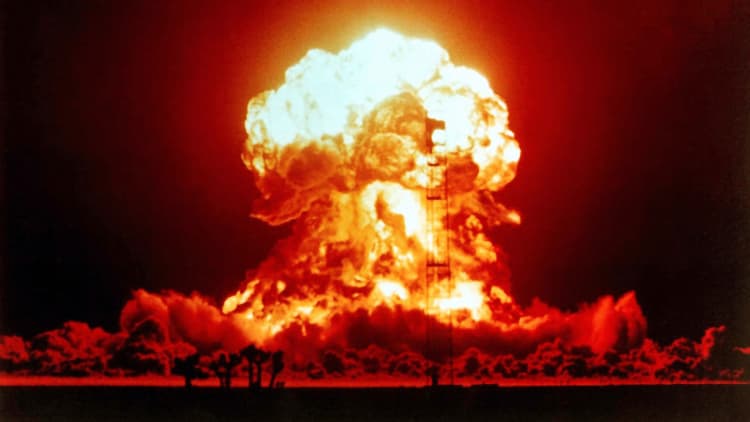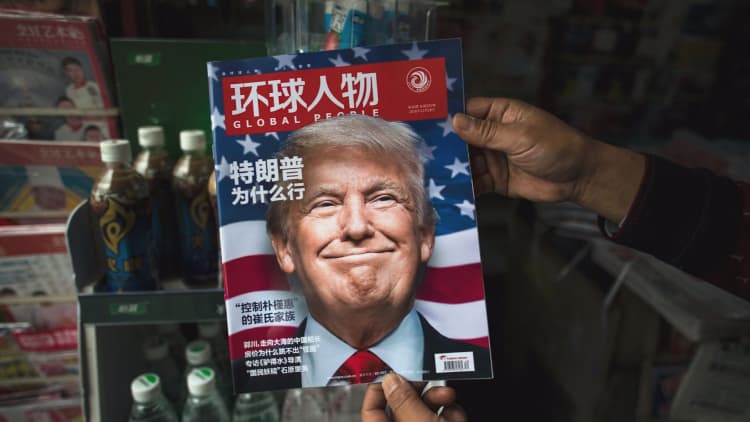The nuclear threat from North Korea looks greater than ever.
Even as the new U.S. defense secretary warned North Korea on Friday of an "effective and overwhelming" response if the rogue state uses nuclear weapons, images indicate that Pyongyang continues to rapidly build out its missile program — research, development and facilities for storing, launching and testing missiles.
"There's a lot going on. It's not looking good," said David Schmerler, research associate at the James Martin Center for Nonproliferation Studies.
Schmerler is part of a team that analyzes pictures from Google Earth and private satellite imaging firm Planet Labs over time, using propaganda videos and other sources to tip them off on where and how to scrutinize most closely.

In his analysis of several North Korean missile development and launch areas, Schmerler has in recent weeks identified a new missile facility that he said is "significantly larger" than comparable facilities in the country.
Video still of satellite launch vehicle
Sanum-dong facility aerial shot in 2016
Sanum-dong in 2011
Sanum-dong in 2009
Source for all 4 images: James Martin Center for Nonproliferation Studies.
Footage from a North Korean network showed dictator Kim Jong Un inspecting a large satellite launch vehicle at the building last February, Schmerler said. His research put the building at Sanum-dong in the northern part of the capital, Pyongyang.
Details on the structure have previously not been released.
Satellite launch vehicles — big rockets, essentially — are not weapons, but their development shows how quickly North Korea's ballistics technology has advanced. Tests of the projectiles can provide valuable data for further weapons development.
"The reality is that if North Korea doesn't test those missiles, its program doesn't advance. One thing the U.S. has to think about is, how do you prevent them from testing?" said Bruce Bennett, senior defense analyst at research organization Rand Corp.
The findings come as North Korea held two nuclear tests in 2016 and has greatly advanced its technological capabilities.
The northeast Asian nation has conducted more than 20 missile tests, fired missiles from submarines, tested a rocket nose cone for its ability to withstand the heat of re-entry, and claimed its first hydrogen bomb test — all in the last year.
Schmerler's team had an informal set of criteria they believed the rouge state had to achieve before the researchers got worried. "Last year," Schmerler said, "North Korea kind of checked off that entire list."
North Korea ballistic missile and weapons sites
Source: Google, James Martin Center for Nonproliferation Studies.
When Schmerler looked at satellite images of Sanum-dong this year, he found a building with a unique skylight and 12-beam structure that matched the interior footage.
Prior to 2009, Schmerler had seen only a small, non-military related structure in that location, but new construction began by 2012, satellite images reveal. He estimates the main hall is about 66-by-30 meters large, or more than 21,000 square feet. That's plenty of room to hold what he believes is a 30-meter Kwangmyongsong rocket.
Using satellite images from Planet Labs, Schmerler has seen increased activity at other North Korea missile-related locations, including paving work near the Sohae Satellite Launching station.
More weapons tests to come?
Kim said in a New Year's Day speech that his country is close to a test launch of an intercontinental ballistic missile. Such a test could come in the next few months.
North Korea celebrates the birthdays of Kim's father and grandfather in February and April, and state commemoration of the former dictators could prompt Kim to test weapons in a show of strength. The U.S. and South Korea will hold military exercises in the coming weeks. South Korea is also expected to hold a presidential election this year.
"I think you're right to suspect things are a lot more combustible in Asia now," said Isaac Stone Fish, senior fellow at Asia Society's Center on U.S.-China Relations. He likened the tensions to those around the Vietnam War, Tiananmen Square and the collapse of the Soviet Union.
However, weapons tests have calmed in the last several weeks. Experts say Kim is waiting to see how South Korea's elections unfold. President Donald Trump also remains an uncertainty.
An increasing priority for the US
Trump has called the North Korean dictator a "bad dude" and a "maniac," but also once suggested that the two could meet over hamburgers to discuss improving the countries' relationship.
North Korea appears to be a top U.S. foreign policy concern, given that James Mattis made his first overseas trip as the new U.S. secretary of defense to South Korea. During his two-day trip, Mattis reiterated the U.S. commitment to deploying an anti-ballistic missile system in South Korea this year.
"Secretary Mattis was very effective in reassuring this important U.S. ally, and also strengthening deterrence against North Korea, without being unnecessarily provocative," Bennett said. "This is a very positive outcome from his visit to South Korea."
WATCH: Why Trump's foreign policy is on a collision course in the South China Sea



